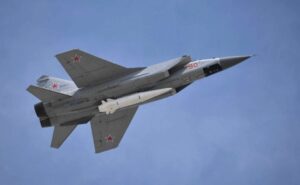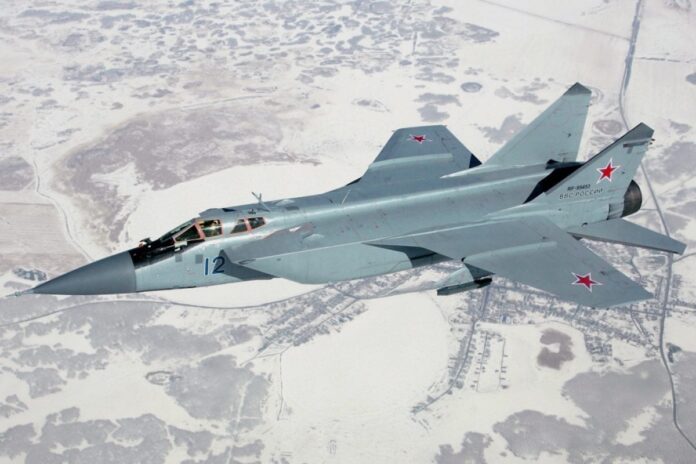In what could be described as muscle-flexing with the West, the Russian government has reportedly deployed fighter jets armed with Kinzhal (NATO nomenclature: AS-24 KILLJOY) missiles to Belarus, according to the United Kingdom (UK’s) Ministry of Defense (MoD).
The combination of MiG-31K and Kinzhal missile is the most potent conventional weapon system in Russia’s arsenal. The deployment puts all possible targets in Europe and the UK, even the most heavily defended ones, at risk, reports euasiantimes.
READ ALSO: Russia brings down Ukrainian fighter jet with long-range R37-M missile
According to the medium, Russia that is currently carrying out ‘a special military operation in Ukraine on Tuesday deployed a Kinzhal missile, over cities in broad daylight and letting Western satellites take a good look at what may well be the next Russian step on the escalation ladder.
On October 16, 2022, six Russian MiG-31K fighters with Kinzhal missiles were spotted over the Belarusian capital of Minsk.
According to the Ukrainian National Resistance Center, “three IL-76 military transport aircraft of the Russian Air Force flew to the airfield ‘Machulyshchi’ from the Russian Federation” to support the Russian deployment in Belarus.
On October 20, 2022, one MiG-31K armed with Kinzhal reportedly took off from Machulyshchi air base in Belarus.
On November 1, 2022, the UK Ministry of Defense (MoD) tweeted, “imagery showed two MiG-31K FOXHOUND interceptor jets were almost certainly parked at Belarus’s Machulishchi Airfield on October 17, with a large canister stored nearby within a protective earth berm.
“It is likely that the canister is associated with the AS-24 KILLJOY air-launched ballistic missile, a large munition which the MiG-31K variant is adapted to carry.”
The Kinzhal is an air-launched aeroballistic missile with a range of over 2000 kilometers when launched from a MiG-31K. The hypersonic missile cannot be accurately tracked using radar because, at hypersonic speeds, the air pressure in front of it forms a plasma cloud that absorbs radio waves.
The missile is capable of advanced maneuvering ruling out engagement by any existing anti-ballistic missile (ABM) defense system.
The 2,000-kilogram missile with a speed of Mach 12 can strike a target with pinpoint accuracy. Because of its high impact speed, the missile’s 500-kilogram warhead packs destructive kinetic energy of 16.9 gigajoules, the equivalent of 4,000 kilograms of TNT.
The Kinzhal is essentially the 9K720 Iskander missile adapted for launch by high-speed aircraft. It can hit static and mobile targets such as aircraft carriers.
The Kinzhal was first used during the ongoing Russian Special Military Operation (SMO) in March 2022 when it struck a military fuel depot near the southern Ukrainian city of Mykolaiv.
The deployment of MiG-31K with Kinzhal missiles is significant because, so far, the weapon system has not been operationally deployed outside Russia. There was no need to do so since Russia could strike at any target within Ukraine from within Russia.
Deployment in Belarus will allow Russia to strike at any European target, including the UK. There is a message. This message is reinforced by Russia’s lack of secrecy around the deployment.
The UK MoD acknowledges the Russian messaging with the last tweet in the above linked Twitter thread, saying, “It (Russia) has likely carried out the deployment mainly to message to the West.”
Russia’s deployment of the MiG-31-Kinzhal combination in Belarus followed massive Russian attacks on Ukrainian power generation infrastructure on October 10 & October 11.
The Russian attacks, which were a retaliation to Ukrainian intelligence masterminded terror attack on the Kerch bridge, destroyed 30% of Ukrainian power generation capacity.

On October 31, 2022, Russia again struck the Ukrainian power infrastructure, targeting power distribution infrastructure. This time the provocation was the massive drone attack on the Russian Black Sea fleet controlled and coordinated by Ukrainian, US, and UK forces.
If Russia persists in striking down Ukrainian power generation and distribution infrastructure, the Ukrainian economy will likely collapse despite the infusion of Western economic assistance. A Ukrainian defeat would then be inevitable. The question is, would the defeat be acceptable to the US and NATO?
The US and its Western allies could transgress Russian red lines to stave off a Ukrainian defeat.
The participation of US and British forces in the drone attack on the Russian Black sea fleet may well be a transgression from the Russian point of view.
It’s possible that such Western transgressions will increase. Other Western actions which Russia could perceive as transgression would include the supply of offensive weapons, such as fighter aircraft and long-range missiles, or the declaration of a no-fly zone.
Kinzhals are likely to be an important component of the Russian response to Western transgression of Russian redlines.
Strikes on airfields in Europe, including the US Ramstein air base, that serves as logistics hubs for the supply of US weapons to Ukraine.
Strike on critical rail and road choke points along Ukraine’s border with Poland and Romania.
Russia is sending a strong message to the West by deploying MiG-31K armed with Kinzhal missiles. The weapon combination has the ability to hit hard and accurately. More importantly, the adversary has no defense against Kinzhal.
EUASIANTIMES
Follow the Neptune Prime channel on WhatsApp: https://whatsapp.com/channel/0029Va74ZvU2v1IqKByXoX3d
Do you have breaking news, interview request, opinion, suggestion, or want your event covered? Email us at neptuneprime2233@gmail.com


